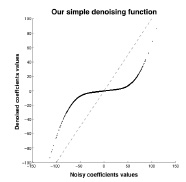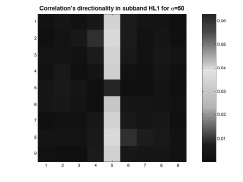|
In the processes of acquisition and trans-mission, images are often corrupted by additive noise. The most successful way of reducing its level is to apply a denoising function in the wavelet domain, where noise is concentrated in the lowest coefficients, while most image information remains in the highest ones.
In this work, we prove the great reliability of Stein's unbiased risk estimator (SURE), by using its quadratic form to build a new parameterized denoising function with various degrees of freedom. We show that, for a comprehensive set of images and for a wide range of noise level, our solution gives the best available results in terms of peak-signal-to-noise ratio.

Our new linearly parametarized denoising function
To better preserves image features, we have extended our approch to the multi-dimensional case. Therefore, one can take into account the spatial correlations between the degraded wavelet coefficients of a same neighborhood.
One has observed that this correlation is very directional, due to the wavelet filters themselves. The integration of the local spatial context into our nearly optimal punctual function leads to significant improvement of the denoising quality.

Directionality of intra-scale correlations
We have also highlight the inter-scale correlations between contiguous subbands. We state that a good handling of these various correlations will make non-redundant transformations as efficient as undecimated ones.
Finally, we have evaluated the denoising performance of several orthogonal wavelet bases and found that the complex-valued B-splines bring the best results, in spite of the only partial exploitation of their potential. A further step will be to validate our approach on a practical case, such as fMRI statistical analysis.
|